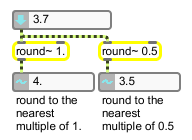Examples

round~ takes floating-point signals and rounds them to a specific increment
Round an input signal value
| Name | Type | Opt | Description |
|---|---|---|---|
| int or float | int or float | opt | Sets the value to which the input signal will be rounded. The default value is 0. (no modification). |
| int | rounding-multiple-specifier [int] |
In right inlet: an or will cause the input to be rounded to the nearest multiple of the specified number. If a signal is attached to the inlet, and messages are ignored. |
| float | rounding-multiple-specifier [float] |
In right inlet: an or will cause the input to be rounded to the nearest multiple of the specified number. If a signal is attached to the inlet, and messages are ignored. |
| signal | In left inlet: A signal whose values will be rounded. In right inlet: A signal whose value is used for rounding. Signal values received in the left inlet will be rounded to either the absolute nearest integer multiple or the nearest integer multiple between the value received in this inlet or 0 (see the message for more information). |
| Name | Type | g/s | Description |
|---|---|---|---|
| nearest | int | When set to 1 (the default), the round~ object will round to the nearest multiple of the specified signal value. Note: This attribute does not set the rounding step (which is set using round~ object's right inlet), It specifies that rounding to the nearest signal value will occur. Here are some examples: With the rounding interval set to 3 and the attribute set to 1: an input signal value of 5.8 will return 6 an input signal value of 3.7 will return 3 an input signal value of -1 will return 0 an input signal value of -2.7 will return -3 With the rounding interval set to 3 and the attribute set to 0: an input signal value of 5.8 will return 3 an input signal value of 3.7 will return 3 an input signal value of -1 will return 0 an input signal value of -2.7 will return 0 |

| Name | Description |
|---|---|
| rampsmooth~ | Smooth an incoming signal |
| slide~ | Filter a signal logarithmically |
| trunc~ | Truncate fractional signal values |
| round | Round to an input value |